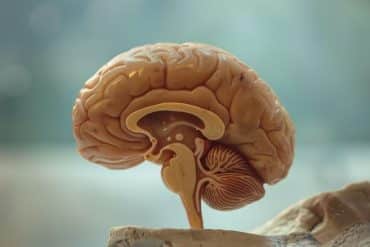Summary: A new fruit fly study reveals a simple genetic system is behind complex movements. The finding sheds light on motor control issues associated with neurodegenerative diseases.
Source: University of Sussex
Neuroscientists at the University of Sussex have revealed that complex movements, such as those that maintain our posture, can be controlled by a simple genetic system, providing a framework to better understand the molecular basis of diseases that affect motor control, like Huntington’s and Parkinson’s.
Claudio Alonso, Professor of Developmental Neurobiology and Wellcome Trust Investigator at the University of Sussex, and colleagues studied a motor sequence in fruit flies called ‘self-righting’, which sees a change in posture involving the rotation of the body so as to maintain a constant position in respect to the ground.
Such movements are also seen in humans; rolling in babies represents one of the milestones to monitor motor development during infancy, and can form part of the repertoire of core motor sequences that control “body posture” providing the basis to all movements such as lifting an arm.
In Professor Alonso’s new research paper, published in the journal Current Biology, he shows that, in fruit flies, these movements are controlled by a simple genetic system where one gene, called miR-iab4, represses another, a Hox gene, to enable ‘self-righting’ behavior. Similarly, in mammals, a parallel gene to miR-iab4, is also able to repress Hox gene expression, demonstrating the common genetic circuitry present in flies and mammals.
Until now, scientists thought that the Hox genes were just developmental, involved in the formation of body structures and the brain, but Professor Alonso and colleagues at the Champalimaud Institute in Lisbon, now show that these genes are also able to control neural physiology and behavior.
The findings could help to provide a framework to better understand the molecular basis of motor diseases like Huntington’s and Parkinson’s.

Professor Alonso, Subject Chair for Neuroscience at the School of Life Sciences and a member of the internationally-leading research center of Sussex Neuroscience, said: “Although our work is focused on deducing fundamental biological principles – what you may call “basic science” – there are several possible biomedical projections of this study.
“For example, aging, as well as various forms of neural disease including motor neuron disease, Parkinson’s and Huntingdon’s disease, can degrade posture and motor control, leading to a deterioration of health and quality of life.
“In order to understand more about these conditions and to be able to map the anomalies caused by disease or advanced age, we need a deeper understanding of the genetic and physiological factors that underlie normal posture control and movement.
“While we knew that deregulation of the Hox genes can cause several types of disease and disorders, including cancer, as far as we know our results are the first to report Hox-dependent roles in neurophysiological and behavioural control in the fully formed organism (once development has concluded).”
Funding: The work was funded by a Wellcome Trust Investigator Award given to Professor Claudio Alonso at Sussex Neuroscience, who worked with two post-doctoral colleagues, Drs. Raouf Issa and Joao Picao-Osorio, alongside European collaborators Dr Eugenia Chiappe and PhD student Nuno Rito at the Champalimaud Neuroscience Program in Lisbon, an international centre of excellence in neuroscience research.
Source:
University of Sussex
Media Contacts:
Stephanie Allen – University of Sussex
Image Source:
The image is credited to Dr. Raouf Issa.
Original Research: Open access
“A Single MicroRNA-Hox Gene Module Controls Equivalent Movements in Biomechanically Distinct Forms of Drosophila”. A. Raouf Issa, João Picao-Osorio, Nuno Rito, M. Eugenia Chiappe, Claudio R. Alonso.
Current Biology. doi:10.1016/j.cub.2019.06.082
Abstract
A Single MicroRNA-Hox Gene Module Controls Equivalent Movements in Biomechanically Distinct Forms of Drosophila
Highlights
• The fruit fly miRNA gene miR-iab4 controls the same behavior in the larva and adult
• miR-iab4 exerts its behavioral roles via repression of the Hox gene Ultrabithorax
• miRNA/Hox inputs affect the physiology and not the anatomy of specific motor neurons
• Conditional expression shows a novel role of the Hox genes in adult neural function
Summary
Movement is the main output of the nervous system. It emerges during development to become a highly coordinated physiological process essential to survival and adaptation of the organism to the environment. Similar movements can be observed in morphologically distinct developmental stages of an organism, but it is currently unclear whether or not these movements have a common molecular cellular basis. Here we explore this problem in Drosophila, focusing on the roles played by the microRNA (miRNA) locus miR-iab4/8, which we previously showed to be essential for the normal corrective response displayed by the fruit fly larva when turned upside down (self-righting). Our study shows that miR-iab4 is required for normal self-righting across all three Drosophila larval stages. Unexpectedly, we also discover that this miRNA is essential for normal self-righting behavior in the adult fly, an organism with different morphology, neural constitution, and biomechanics. Through the combination of gene expression, optical imaging, and quantitative behavioral approaches, we provide evidence that miR-iab4 exerts its effects on adult self-righting behavior in part through repression of the Hox gene Ultrabithorax (Ubx) in a specific set of adult motor neurons, the NB2-3/lin15 neurons. Our results show that miRNA controls the function, rather than the morphology, of these neurons and demonstrate that post-developmental changes in Hox gene expression can modulate behavior in the adult. Our work reveals that a common miRNA-Hox genetic module can be re-deployed in different neurons to control functionally equivalent movements in biomechanically distinct organisms and describes a novel post-developmental role of the Hox genes in adult neural function.






